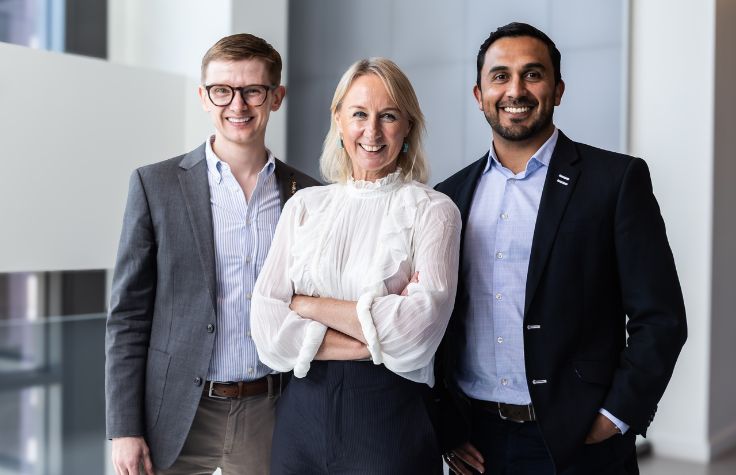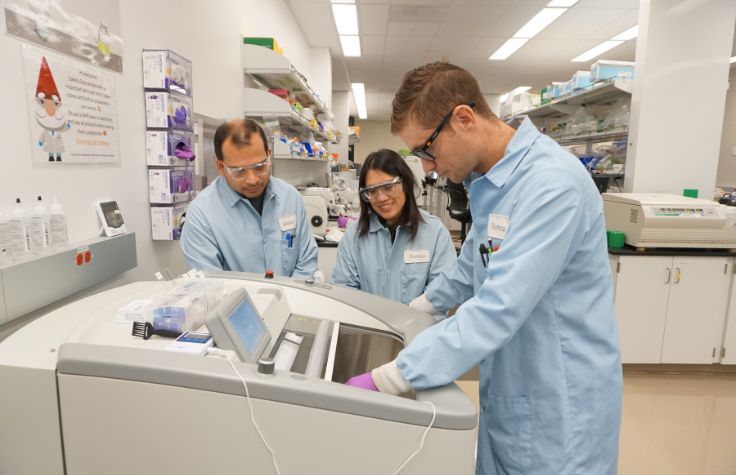
February 12, 2025
University College London counts no less than Francis Crick, co-discoverer of DNA’s double helix structure, among its prestigious alumni. So it’s only fitting that the university’s genomics core facility is among the most prolific in the United Kingdom.
UCL Genomics takes on an average of 2000 projects every year, comprising hundreds of thousands of samples. That means they’ve got about 30 projects running simultaneously in any given week. The facility is completely open to all collaborations and takes projects from partners in the UK and across the world; most of them are medically related, but they have also supported research in archaeology, botany, marine biology, and other fields. UCL Genomics offers the entire genomics workflow, from project design and nucleic acid extractions to data analysis.
And all of this work is handled by a staff of 30—all of them former researchers or expert technical specialists who can advise on the most cost-efficient way of generating and interpreting data. How do they manage such an astounding volume of projects, week in and week out, in an academic setting? The facility’s director, Mark Kristiansen, gives some of the credit to Illumina’s microarray protocols.
Three of UCL Genomics’ 12 workstreams are dedicated to microarray operations: one for genotyping arrays, one for pharmacogenomics microarrays, and one for methylation profiling exclusively using the Illumina Infinium MethylationEPIC v2.0 Kit. They’ve set up a sturdy, proven high-throughput pipeline, allowing them to perform methylation profiling every day with clinical methylation operations twice a week, every week—even during the entirety of the COVID-19 pandemic.
Kristiansen confidently wagers that UCL Genomics is one of the largest academic facilities in the UK that offers both clinical and research microarray processing. Their facility is located in the Zayed Centre for Research into Rare Disease in Children, part of the UCL Great Ormond Street Institute for Child Health. They collaborate closely with many hospitals and neuroscience clinics, and Kristiansen reports that all their hospital collaborators know they can submit samples (on Mondays and Wednesdays) to UCL Genomics and are guaranteed to get their data within 72 hours.
Some of their most important work in this arena is supporting teams in stratifying pediatric neuronal tumors into specific therapy groups, which better informs treatment regimens for pediatric patient groups. “It’s almost the operation that everything else is centered around,” Kristiansen says, and adds that their 72-hour turnaround time “has helped revolutionize the way these children are receiving treatments.”

Oliver Rushton and Kera Pearce train to use the MethylationEPIC microarray at UCL Genomics. | Photo courtesy of UCL Genomics
Although he’s in a leadership position now, Kristiansen has done the hands-on work. His background is in clinical neuroscience, and he earned his PhD from UCL in the molecular mechanisms of prion disease. “When I joined UCL Genomics, I was originally the person in the lab running all the microarrays, going back 15 years ago when they started to become high throughput,” he says. “Automation and Illumina microarray protocols using the Infinium MethylationEPIC v2.0 Kit have significantly increased efficiency in supporting methylation profiling.”
Throughout his career, he has always directed his colleagues’ focus to equitable access, and he remembers how excited they all felt when Illumina announced its Global Screening Array in 2018: “This was something that we’d been desperately missing in addressing the genomic diversity in the world.” The high throughput, affordable price, and robust protocols meant that “suddenly, everybody wanted to be part of it. We joined consortia to say, ‘Look, we’re going to run these GSA BeadChips, and our operations have to quadruple in the space of just a few months. So we increased our microarray team fourfold just to cope with the increased local demand.” With support from Illumina, this quickly expanded to international operations.
Today, he can say without hesitation exactly why his facility exclusively uses Illumina microarrays. “First, they are really affordable for research groups, industry partners, and clinical groups who are interested in working with us to push through a lot of samples very, very quickly. Second, the way the protocols are set up means we can actually do two complete runs every single day, if we wanted to, which could mean tens of thousands of samples processed on Illumina microarrays every week. We’ve shown exactly how robust these microarray protocols are, how reliable the data is.”
Importantly, UCL Genomics operates on a 100% cost recovery model, which helps to make accessing microarray profiling affordable for all. “The amount of data you get makes genotyping and methylation arrays absolute value for money,” Kristiansen says. It’s so affordable that many of their clients can do a quick initial screening using microarrays before deciding to sequence further in depth, using one of the many sequencing streams at UCL Genomics.
For the past couple years, UCL Genomics has been building better, more ethnically diverse data sets that hold up to established biomarker discovery platforms. “We’ve got so many amazing collaborators from around the world willing to share information,” Kristiansen says. “Partners in all six major continents submit samples to us so we can build a better repository that represents the diversity of the world, to see if those biomarkers we discovered 15 to 20 years ago still hold up in a more diverse population.”
The next big challenge, as he sees it, is in making sure every country and every individual has equitable access to these therapies—and the key there, he believes, is education. “Education underpins everything,” he says. “The more we talk about genomics, the more we normalize why we’re using it for the benefit of the patient. Getting the public and the patient on board is essential!”
Supporting this goal, UCL Genomics runs and supports many educational initiatives and they’re working on novel ways of engaging students from all over the world—using interactive elements and even virtual reality—to ensure they’re aware of the growing power of genomics, and more fully integrating genomics into their curricula.
In the next 10 to 20 years, Kristiansen sees the demand for microarray technology only increasing—and that will also mean demand for more bioinformatics support. “There is always, always going to be a need for genomics, and certainly for microarrays,” he says. “I remember when I started, it was really only gene expression microarrays, and that has been pretty much superseded by RNA sequencing. But the throughput you can get from genotyping and methylation using Illumina microarrays is only going to get bigger and bigger. Today, it still remains one of the most economical choices.”
Thinking on the perennial importance of this research, he continues: “In genomics, we know there must be an answer for everything. There’s a reason why we have this mutation, or that gene is switched on or off. There’s a reason—perhaps an environmental one—why certain parts of the genome are methylated. Now we have access to really amazing technologies, through Illumina for example, that have revolutionized the way we generate data as we move into the era of personalized medicine. That means we’re no longer trying to find therapies for a disease—we’re trying to find therapies for the individual. That’s what matters.” ◆


